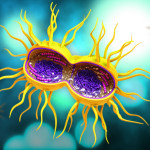Compared with Norvir (ritonavir), people living with HIV using Gilead Sciences’ novel boosting agentcobicistat were just as likely to see their viral loads drop to undetectable levels and experience CD4 cell gains, according to results from a small study comparing both drugs in combination with Reyataz (atazanavir) and Truvada (tenofovir plus emtricitabine). As for side effects, the authors, in a paper published ahead of print by the scientific journal AIDS, reported no major differences between the two drugs.
Cobicistat, formerly known as GS-9350, is an experimental pharmacokinetic enhancer—a drug used to boost other medications in the blood to make them more effective. It is being developed as an alternative to Norvir, a protease inhibitor (PI) once used to treat HIV but now prescribed at low doses to boost the blood levels of other PIs, notably Reyataz, Lexiva (fosamprenavir), Prezista (darunavir), Aptivus (tipranavir) and Kaletra (lopinavir plus ritonavir).
Cobicistat’s potential as a Norvir alternative is important. For starters, while it has a pronounced effect on the enzyme system (CYP3A) responsible for breaking down several HIV drugs, it doesn’t affect other enzyme systems used by many other medications—a common problem with Norvir that contributes to numerous potentially harmful drug interactions. The drug also doesn’t impair fat cell functions like Norvir does, at least not in test tube studies, meaning that cobicistat may be less likely to count fat accumulation and insulin sensitivity problems as side effects.
Gilead has been committed to testing cobicistat as a stand-alone drug in combination with other companies’ drugs that generally require boosting. Gilead is also exploring cobicistat in combination with its experimental integrase inhibitor elvitegravir and Truvada as a once-daily fixed-dose combination tablet.
Richard Elion, MD, of Whitman-Walker Clinic in Washington, DC, and his colleagues allotted 50 HIV-positive individuals starting antiretroviral therapy for the first time to receive 150 milligrams (mg) cobicistat and 29 matched volunteers to received 100 mg Norvir, both in combination with Reyataz and Truvada.
Similar rates of virologic suppression—defined as a viral load below 50 copies—and CD4 cells gains were maintained through the follow-up period. After 48 weeks of treatment, 82 percent in the cobicistat group and 86 percent in the Norvir group had viral loads below 50 copies/mL. CD4 cells increased, on average, by 230 and 206 cells by the end of the study.
According to Elion’s group, these results are similar to those seen in other clinical trials exploring the efficacy of Norvir-boosted Reyataz, as well as Norvir-boosted Lexiva and Kaletra.
As for adverse health outcomes, Elion and his colleagues note that the study was not designed to yield detailed comparisons, but some important observations were made.
Both treatment groups appeared to have similar numbers of volunteers with treatment-related side effects except for nausea, which occurred in five patients in the cobicistat group and one patient in the Norvir group. Whether this difference was statistically significant—meaning large enough not to have occurred by chance—was not determined by the researchers.
The incidence of moderate bilirubin level increases was similar in both groups. However, levels of the liver waste product tended to be somewhat higher in those receiving cobicistat compared with Norvir, though jaundice—yellowing of the eyes and skin—was no more prevalent or severe among those using Gilead’s boosting alternative.
Changes in total cholesterol, triglycerides, “bad” LDL cholesterol and “good” HDL cholesterol were similar in both groups—no statistically significant differences were observed.
Decreases in estimated glomerular filtration rates (eGFR)—a measure of kidney function—were also documented in both groups. Though drops in eGFR were initially more pronounced in the cobicistat group, no statistically significant difference was noted after 24 or 48 weeks in the study.
Elion’s group noted that a larger Phase III study of cobicistat, compared with Norvir, will ultimately shed more light on adverse event similarities and differences between the two drugs. Until then, the authors conclude, cobicistat and Norvir appear to have “comparable rates of virologic suppression and CD4 count increases with satisfactory safety profiles.”
Advertisement
Advertisement
Advertisement






Comments
Comments